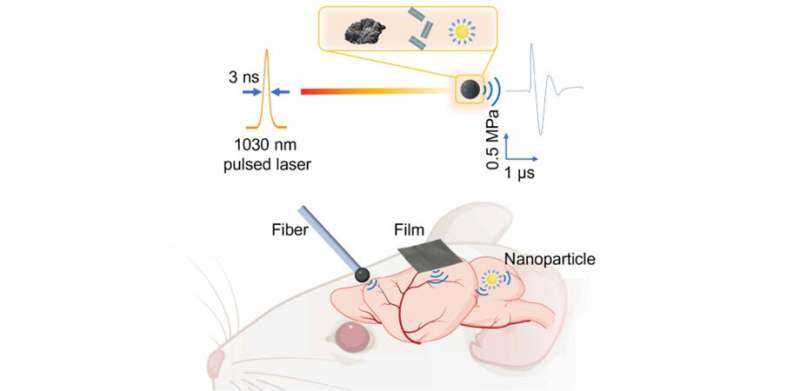
Neuromodulation plays an important role in deciphering neural circuits and exploring clinical treatment of neurological diseases. Optoacoustic neuromodulation is a new and versatile modality that offers the high penetration depth of ultrasound, plus the high spatial precision of photons.
The optoacoustic process involves pulses of light that are converted into acoustic waves at ultrasonic frequencies. The life sciences have witnessed rapid development of optoacoustic technologies, for imaging of living biological structures—ranging from subcellular structures to organs, and even whole animals.
A team at Boston University recently started to make use of optoacoustics for high-precision neuromodulation. By repurposing an optoacoustic emitter originally developed for surgical guidance, they developed the first example of optoacoustic neurostimulation. More recently, they created a new type of optoacoustic emitter that extends precision to the single neuron and subcellular level. In a primer published in Neurophotonics, they discuss device design considerations, potential mechanisms, and barriers to the uptake of optoacoustics as a viable neuromodulation tool. They also offer their perspective on future directions in fundamental and translational research for the field.
Optoacoustic neuromodulation can be achieved through a variety of techniques. Neuron stimulation, which has been successfully applied for treating neurological and psychiatric disorders, including epilepsy, Alzheimer’s, Parkinson’s, and treatment-resistant depression, may find a new method in optoacoustics. As such, optoacoustic neuron stimulation would avoid problems associated with electric stimulation and achieve better precision to reach finer nerve fibers, for example, in children with cerebral palsy.
Some of the novel optoacoustic techniques surveyed in the primer include fiber-based neurostimulation, biocompatible films, and nanoparticle mediation. Multiplexed emitters in the form of fiber or film-based arrays may potentially be used for stimulation, for instance, to retinal ganglion cells for visual prothesis.
Highly miniaturized fiber-based optoacoustic emitters could deliver drugs into cellular membranes, or be integrated into medical devices, such as catheters and needles, to provide real-time surgical guidance.
Complementary with fiber-based optoacoustic emitter devices, biocompatible optoacoustic films may serve as a new neural interface, offering multiple functions, from optoacoustic stimulation to structural support and growth guidance. As a platform for bioelectronics and basis for tissue scaffolding, biocompatible optoacoustic films have been shown to enhance regeneration effects in bone engineering. They have also proven capable of promoting neural regeneration, by increasing the secretion of brain-derived neurotrophic factors. As a light-mediated technique, the optoacoustic scaffold eliminates the requirements of wire connections and genetic modifications.
Source: Read Full Article
